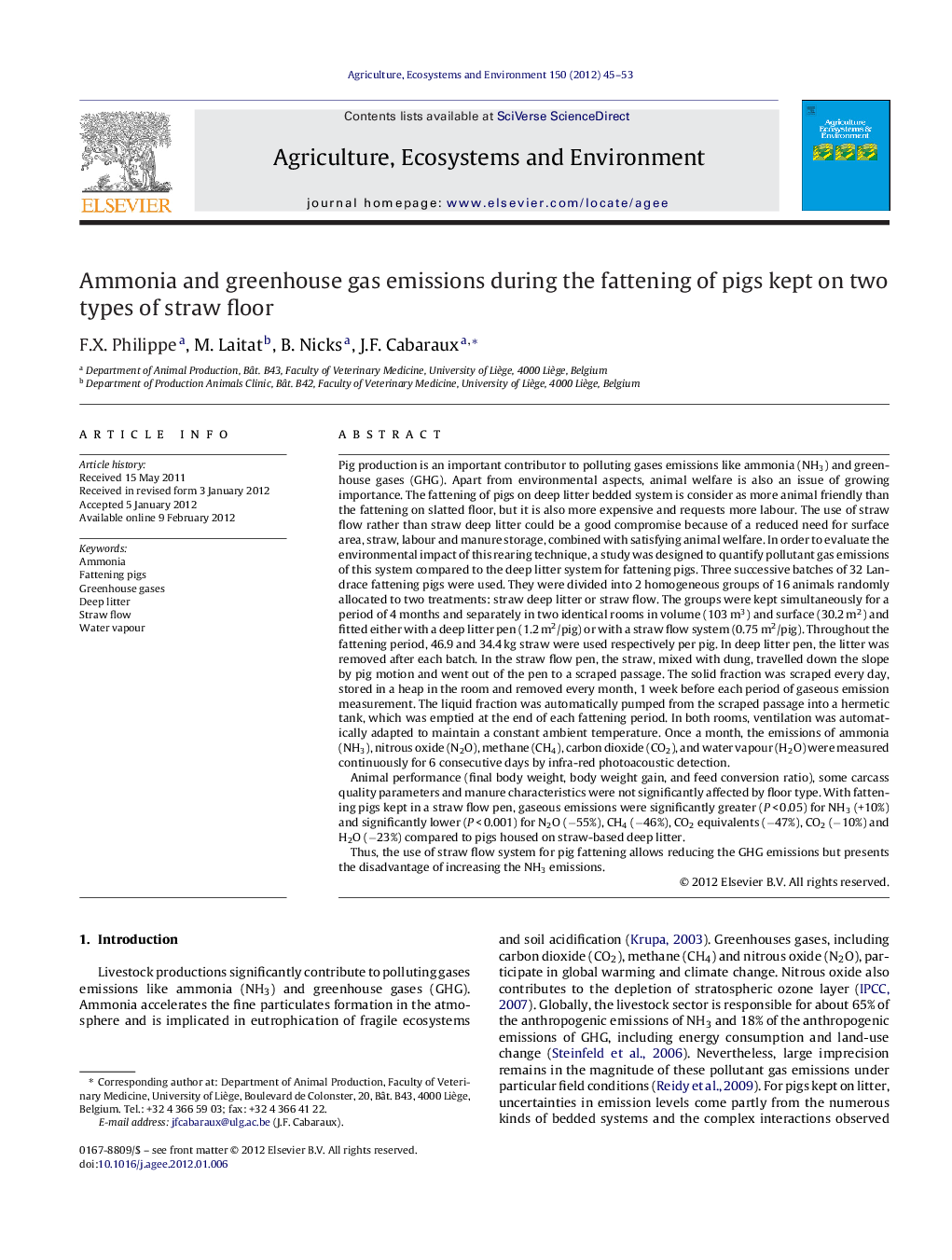| کد مقاله | کد نشریه | سال انتشار | مقاله انگلیسی | نسخه تمام متن |
|---|---|---|---|---|
| 2414518 | 1552102 | 2012 | 9 صفحه PDF | دانلود رایگان |

Pig production is an important contributor to polluting gases emissions like ammonia (NH3) and greenhouse gases (GHG). Apart from environmental aspects, animal welfare is also an issue of growing importance. The fattening of pigs on deep litter bedded system is consider as more animal friendly than the fattening on slatted floor, but it is also more expensive and requests more labour. The use of straw flow rather than straw deep litter could be a good compromise because of a reduced need for surface area, straw, labour and manure storage, combined with satisfying animal welfare. In order to evaluate the environmental impact of this rearing technique, a study was designed to quantify pollutant gas emissions of this system compared to the deep litter system for fattening pigs. Three successive batches of 32 Landrace fattening pigs were used. They were divided into 2 homogeneous groups of 16 animals randomly allocated to two treatments: straw deep litter or straw flow. The groups were kept simultaneously for a period of 4 months and separately in two identical rooms in volume (103 m3) and surface (30.2 m2) and fitted either with a deep litter pen (1.2 m2/pig) or with a straw flow system (0.75 m2/pig). Throughout the fattening period, 46.9 and 34.4 kg straw were used respectively per pig. In deep litter pen, the litter was removed after each batch. In the straw flow pen, the straw, mixed with dung, travelled down the slope by pig motion and went out of the pen to a scraped passage. The solid fraction was scraped every day, stored in a heap in the room and removed every month, 1 week before each period of gaseous emission measurement. The liquid fraction was automatically pumped from the scraped passage into a hermetic tank, which was emptied at the end of each fattening period. In both rooms, ventilation was automatically adapted to maintain a constant ambient temperature. Once a month, the emissions of ammonia (NH3), nitrous oxide (N2O), methane (CH4), carbon dioxide (CO2), and water vapour (H2O) were measured continuously for 6 consecutive days by infra-red photoacoustic detection.Animal performance (final body weight, body weight gain, and feed conversion ratio), some carcass quality parameters and manure characteristics were not significantly affected by floor type. With fattening pigs kept in a straw flow pen, gaseous emissions were significantly greater (P < 0.05) for NH3 (+10%) and significantly lower (P < 0.001) for N2O (−55%), CH4 (−46%), CO2 equivalents (−47%), CO2 (−10%) and H2O (−23%) compared to pigs housed on straw-based deep litter.Thus, the use of straw flow system for pig fattening allows reducing the GHG emissions but presents the disadvantage of increasing the NH3 emissions.
► The litter management (amount of substrate, frequency of supply, removal strategy, etc.) greatly impact the emissions of pollutant gases.
► Compared to the straw-based deep litter system, the straw flow system is associated to higher NH3-emissions while the N2O-, CH4-, CO2- and H2O-emissions are reduced.
► The animal performance and the manure characteristics were not greatly influenced by the type of straw litter.
Journal: Agriculture, Ecosystems & Environment - Volume 150, 15 March 2012, Pages 45–53